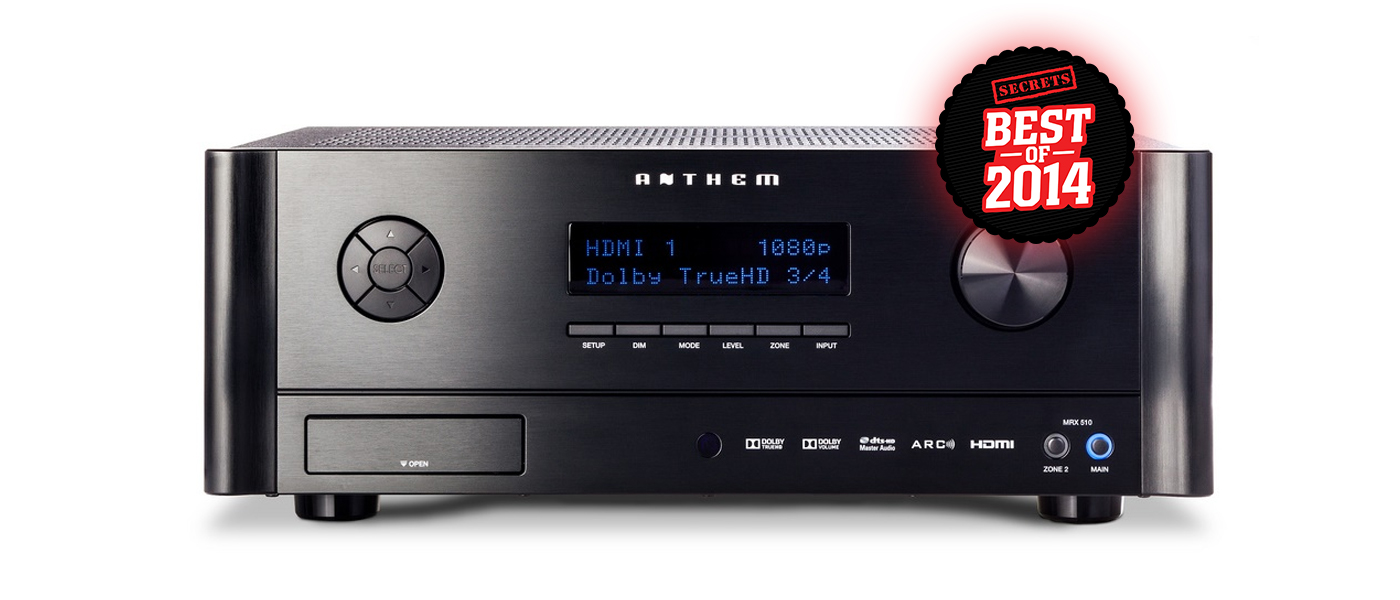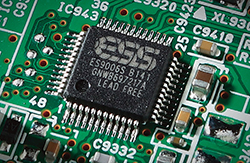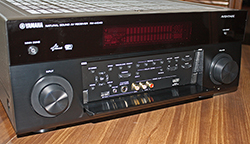Yamaha RX-A1040 7.2 A/V Receiver Review Highlights
The Yamaha RX-A1040, one of the “Aventage” flagship line of AVRs.
This is an amazing receiver, offering a full slate of features equivalent to those offered by any of their competitors. The 4K pass-through puts the Yamaha ahead of many on the market. The sound is dynamic and the video performance is superb. The iPad interface to the receiver is very intuitive. Straightforward set-up…..bottom line the RX-A1040 is worth serious consideration.

Yamaha RX-A1040 7.2 A/V Receiver Highlights Summary
- Improved parts quality for better audio performance
- Attention to resonance control
- WebBrowser Control from a PC or PDA
- FLAC 96/24 (Free Lossless Audio Codec) support
- DLNA® 1.5 (for finding and playing digital sources)
- Support for online radio & streaming video
- 4K upscaling
- Use of ESS Technology ES9006 SABRE™ Premier Audio DACs for improved audio quality
Introduction to the Yamaha RX-A1040 7.2 A/V Receiver Review
Audio-Video Receivers (AVR’s) have long been considered “entry level only” among audiophiles. In recent years, AVR manufacturers have tried to change that perception by paying attention to audio quality, and by adding more robust power amplifiers to their products. The Yamaha “Aventage” line is the flagship line of Yamaha AVRs. The RX-A1040 model is the middle of Yamaha’s five new “Aventage” receivers.
YAMAHA RX-A1040 7.2 A/V RECEIVER REVIEW SPECIFICATIONS
- Design: 7.2 A/V Receiver
- Power Output: 110 watts/channel x 7;
- THD+N: 0.06%, Two Channels Driven into 8 Ohms (20-20 kHz)
- Stereo Subwoofer Outputs with Independent Correction
- Yamaha “YPAO” Multi-point Room Correction with included Microphone
- Supports most CODECS
- 24/192 DACs on all Channels
- HDMI 2.0 Spec Support, HDMI 3 Pass-through, HDMI Upscaling, and 4K Ultra HD Pass-through and Upscaling
- MHL, Wi-Fi, and AirPlay Support
- USB Input (for music playing from your computer) and 7.2 pre-outs
- Phono Input and Headphone Amplifier
- Dual-zone Output for Program in Other Rooms
- Eco Mode for Power Saving
- Dimensions: 9.5″ H x 17.1″ W x 17.25″ D
- Weight: 32.8 Pounds
- MSRP: $1,199.95 USD
- Yamaha
- SECRETS Tags: Yamaha, Audio Video Receiver, Yamaha RX-A1040, Receivers Reviews 2014
Traditionally, I have preferred audiophile-quality components used in “stereo-only” configuration. I’ve tried AVRs before but ultimately found their sound quality lacking. The most likely cause has been my inadvertent preference for low-impedance, low-sensitivity, or difficult to drive loudspeakers. In the past, I’ve used Thiel 1.5 and 3.6 models (4-ohms with complicated crossovers), Magnepan 1.6 speakers (4-ohms), and currently, Axiom M80 speakers (also 4-ohms).
AVR amplifiers, typically, lack the current capability to easily drive 4-ohm speakers in larger rooms. Yamaha claims to have overcome this issue with their “Total Purity Concept,” design that includes “high-drive amp technology, high purity preamplification, anti-vibration technology and independent “pure power” supplies.” The RX-A1040 has beefed-up power supplies, with independent supplies for the analog and digital circuitry to prevent digital noise contamination. The Yamaha’s ESS Sabre digital to analog converters (DACs) are considered “audiophile grade” and are selected for premium sound quality.
One of the prime advantages of a receiver, of course, is its compactness. In a single component, one replaces a multitude of separates including the digital to analog converter (DAC), the tuner, the multi-channel preamplifier, and the multiple power amplifiers.
The question, of course, is “how well has Yamaha succeeded with their attempt to rival audiophile separates?”
Design and Setup of the Yamaha RX-A1040 7.2 A/V Receiver
I took the Yamaha out of its box and examined the construction. The circuit boards, parts layout, and heat sinks were far flimsier than what I’m accustomed to with separates. Fair enough – the Yamaha costs less than a high-end preamp, much less a DAC/preamp/power-amp combo. But pretty is as pretty sounds – All can be ignored if the unit is reliable and performs well. Despite playing four-ohm loads at fair volumes, the Yamaha never got hot or shut down.
The construction “flimsiness” also extended to such things as speaker connectors. When inserting banana plugs, it seemed that the entire rear panel of the Yamaha flexed excessively. Despite this, Yamaha claims that one of their objectives in the design of this receiver was suppression of chassis vibration. The internal bracing and “fifth foot” in the center of the receiver’s bottom are artifacts of this design priority, but somehow, the flexible rear connection panel seemed to be an inconsistency.
The RX-A1040 is designed to fit in a standard 8” tall audio shelf. The unit’s light weight makes it easy to unpack and move, unlike some “audiophile” amplifiers I’ve owned which approach 100 pounds! The roughly 17” width also is a “standard” size that means that the receiver will fit in most any shelf designed for audio gear. Only the rear antenna, which reaches a height of 9.5” may be a problem for shelves with closed backs.
The front panel has the usual array of inputs and controls, but Yamaha was wise enough to put the microphone input on the front panel, thus avoiding the onerous task of finding the right tiny hole on the back panel in the dark.
I found the Yamaha extremely easy to set up. I initially hooked up the Yamaha to my music server via Ethernet (all non-compressed WAV & FLAC-0 files). My preferred server software is JRiver Media player for PC, and I was pleased to see that JRiver immediately recognized the Yamaha as a DNLA destination. Selecting the Yamaha as the active device in JRiver, I then set the Yamaha’s input to “Net,” and the music instantly played. No fuss, no muss, one of the easiest setups ever!
The remote control matched the instructions contained on the enclosed CD, but I found it just as easy to use the Yamaha iPad app which allowed access to most (but not all) of the remote-control functions. I also found it convenient to access the manual via the iPad although I printed out the manual as well.
I used the setup menu to upgrade the firmware without any issues. I then set the Yamaha to “six-ohm mode” for running lower impedance speakers, but I found no significant sound-signature change with or without the six-ohm mode enabled.
I got out my tripod and mounted Yamaha’s calibration microphone at the listening position. When I plugged the mic into the front of the Yamaha, the YPAO calibration screen came up automatically. I really liked this feature because I didn’t have to dig around in the manual to find out how to run the calibration. The system calibrated itself with the surround speakers on the front wall (per Yamaha’s “Virtual Cinema – Front” mode).
When I switched to multi-channel, one thing that surprised me greatly was how much YPAO homogenized the voicing of my disparate speakers. My main speakers are by Axiom, my surrounds by Polk, and my center by Klipsch, but after YPAO, I could have sworn, from the sound of them, that they were a matched set! Attaboy, Yamaha!
The Yamaha also has a feature that will fine-tune the sound of your speakers so that you can match the “voicing.” In other words, you can ask the Yamaha to make your center & surrounds sound like the right/left fronts, and it will do so. Prior to YPAO, this was a valuable feature. After YPAO, I couldn’t tell much difference in the Axiom front speakers, the Klipsch center speaker, or the Polk surrounds anyway – so the “voicing” feature seemed academic. I used it anyway to be on the safe side.
Using the setup menu, I forced the Yamaha to cross over my main (full-range) front speakers at 80 Hz, rather than the lower frequency selected by YPAO, and the system sounded the better for it. I suspect that the Yamaha was running out of current trying to drive the woofers of the 4-ohm Axioms, and that when relieved of that duty by the higher crossover point, the soundstage improved.
The Yamaha offers considerable flexibility in setup. One can set up the receiver for 2.0, 2.1 – 3.1 – 5.1 – 5.2 – 7.1 or 7.2 channel operation. The built-in Yamaha wireless set can either connect to an existing router’s network or connect directly to a controller such as a cell phone or tablet computer. To do the latter, the Yamaha control program (a free download) must be used. The Yamaha control program lacks all the features that a music program such as JRiver can provide, so it can be considered a “minimalist” option only if you’re considering it as a media browser.
If you can live with the minimalism of the Yamaha’s browser, then you can connect your USB source directly to the receiver and browse the media through the Yamaha app. I didn’t use this feature since I am more familiar with JRiver. I did, however, plug in a USB memory stick to the Yamaha’s front socket & used the Yamaha browser to identify & play the MKV file there. This worked perfectly.
So setup, overall, could be as simple or complex as I wished. The setup worked in an easy and intuitive manner and the remote / iPad app / front panel buttons / manual were straightforward to use and had no discrepancies in their labeling or usage.
The Yamaha RX-A1040 7.2 A/V Receiver In Use
Of course, compactness and economy are academic without performance. So how does the Yamaha sound? My sources are multi-channel SACD audio discs, Blu-Ray movie discs and streaming audio files in WAV and FLAC formats.
My first evening was spent without surround speakers or YPAO room configuration – just plain stereo. After playing the usual sound checks to verify channel identification & phase, I listened to “Caroling, Caroling” by Singers Unlimited. This is a well-sung and well-recorded piece that should clearly differentiate the individual voices and provide a “you are there” effect. The Yamaha passed with flying colors.

Next, just for fun, I cued up Madonna’s “Immaculate Collection” CD. This disc is recorded in “Q-Sound” which already makes for spectacular surround effects, even in “plain old stereo.” Unable to resist, I cued up some of Yamaha’s music DSP effects (classical music halls, club venues, etc.) on top of the already fancy “Q-Sound.” What I heard amazed me. I’ve never heard such effects even from a true 5.1 surround system. With only two stereo speakers, the DSP effects in conjunction with the recording magic already on Madonna’s disc made it sound as if sounds were coming from the back, from the sides, and even from above! I ended up listening to every cut on this album, each more amazing than the previous one. This may, or may not have been “true to the original performance” sound, but it was so much fun that I didn’t care!

I then used a variety of stereo music to assess the effect of YPAO on simple stereo reproduction. Artists included Jennifer Warnes, Norah Jones, Little Feat, Dave Brubeck, and Balkan Beat Box. What surprised me was how little difference YPAO made on the sound of my room. I’ll attribute it to the ATS absorber panels and bass traps that line the room. Attaboy, Yamaha!


In straight stereo listening, the Yamaha impressed me with its non-fatiguing nature. This is not to say that the treble was recessed at all – just that the vocals remained non-screechy even when the loudest passages were sung. The Yamaha never seemed short on power and had excellent dynamics from soft to loud volumes. The soundstage width was excellent, but the depth wasn’t the best I’ve ever heard.
There was also a slightly recessed sounding midrange, relative to the treble & bass. This was true both with and without YPAO. This is not a frequency response anomaly, so far as I can tell – the Yamaha measures ruler-flat. It may be an artifact of the DAC, but I’m unable to competently speculate on the cause – I only note it as a consistent comment on what I hear. Other equipment hasn’t sounded this way in my room (except for one other component that used the same ESS Sabre DAC as the Yamaha). The recessed midrange wasn’t audible enough to cause any grief, but it was a constant throughout my review time with the Yamaha.
If I had to pick out the best thing about the Yamaha’s sound, it would be the dynamics. The RX-A1040 sounded more dynamic than my Oppo BDP-105 driving a 1,000 watt per channel power amplifier directly. I’d probably credit this to good matching on Yamaha’s part between their pre and power amp circuitry. Well done!
I then switched to surround usage to assess the receiver in multi-channel configuration. The first surround mix disc I used was the newly released SACD, “Song of Scheherazade” by Renaissance. I’ve long enjoyed the stereo version of this cut, and am very familiar with the music. With Yamaha’s multi channel presentation, I can truly say that I’ve never heard a broader, richer soundstage.

I then recalibrated the receiver for rear surrounds, and played the blu-ray movie disc, “Gravity.” With the Oppo feeding the Yamaha via HDMI, the surround effects were consistent with the images on the screen, never intrusive, and always effective. Since surround sound is the primary goal of a surround receiver, I’d expect no less.

For video performance, the Yamaha was absolutely perfect. It passed through Blu-Ray 1080p images perfectly. I let the Yamaha rescale some 720p material to 1080p, and saw absolutely no conversion artifacts. The picture from the Yamaha was indistinguishable from the Oppo’s output sent directly to the projector. Black levels and color preferences were unchanged. Buy the Yamaha with full confidence in its video abilities!
Of course, no audio component is perfect, and among the things that I was less than enthused with by the Yamaha were:
- The speaker impedance selection must be performed with speakers disconnected from the receiver and on power-up. It would have been more convenient for this selection to be available from the setup menu, or perhaps automatically configured by the receiver. On the other hand, this is not a setting that will have to be changed often, so the inconvenience should be minimal.
- When switching from one song to another in JRiver, the Yamaha had trouble getting an immediate lock on the bitstream. Switching from one song to another on the fly caused a 1.5 second gap of soft static, and then the Yamaha would pick up the music. This was a disappointment, but there is a workaround; by ending the music stream (pressing the “stop” button on JRiver to end a song), waiting a second, and then starting another song, the Yamaha picked up the new song immediately. Also, I’ve experienced this same behavior with other brands of AV equipment including Denon, HK, Emotiva, and Onkyo, so it may be an artifact of the DAC.
Just to make sure it wasn’t my server or network causing the problem, I switched JRiver to use my Oppo BDP-105 as a source. The Oppo was connected to the Yamaha via HDMI. With this configuration, there was never a skip.
- Although the DSP modes were fun on some program material, the stereo only performance of the Yamaha just didn’t produce as deep a soundstage as my separate components. This was true whether the Yamaha was in “six-ohm mode” or “eight-ohm mode” when driving my four-ohm speakers.
The things I liked best about the Yamaha were:
- Dynamics! The sound had a live-music “jump factor” to it that is often missing in reproduced sound. With my speakers, it was easy to lose yourself in the listening experience.
- YPAO / speaker-matching / DSP modes for movies – The room correction and speaker matching worked perfectly and added significantly to the movie experience. The DSP options added significantly to some music.
- iPad interface – Having significant control over the receiver from my tablet computer was a convenience that was highly appreciated.
- Power – Driving four-ohm speakers (above 80 Hz), the Yamaha sounded pristine even when playing at high sound pressure levels.
Conclusions about the Yamaha RX-A1040 7.2 A/V Receiver
So is it time to sell your Audio Research tube electronics and buy a Yamaha receiver? Maybe not – (but you already knew that). However, with the Yamaha priced at less than a fancy set of speaker cables, the receiver has a lot to offer in a second system dedicated to movies only. The other thing that strikes me about this unit is how much better-sounding this Yamaha is over AVRs produced even a year or two ago. The performance curve is definitely on an upward swing.
This is an amazing receiver; it has enough features to provide you months of entertainment while optimizing the sound quality of your music and movies. Did my brief acquaintance reveal the very best that the Yamaha can do? I doubt it. I think that with time and tweaking of the Yamaha’s varied menu options, somewhat better performance can be had. Nevertheless, the Yamaha’s “out of the box” performance with NO tweaking was very, very good. Most should be perfectly happy with the plug and play performance of the RX-A1040.
Additionally, Yamaha has an excellent reputation for durability and quality control. So for the very reasonable price of this receiver, one can get maybe 90% of the performance of separates for less than 50% of the price. So unless you’re an uncompromising audiophile at heart, maybe it IS time to consider the Yamaha RX-A1040.









